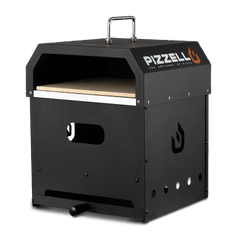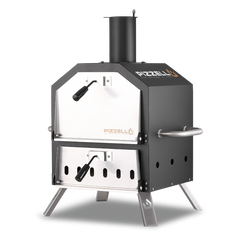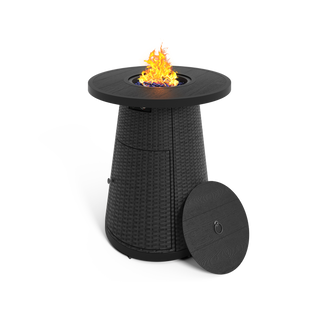How to Make Pizza Dough More Stretchy? Tips From Pizzello

In the article, we delve into the essential techniques and considerations that can transform your pizza-making experience. From understanding the role of gluten development to selecting the right type of flour, this guide provides practical advice to help you achieve that ideal dough consistency.
Whether you're struggling with dough that snaps back or simply looking to enhance your pizza's texture, these tips will guide you toward making a dough that is not only easier to stretch but also results in a deliciously chewy and satisfying crust.
Why is My Pizza Dough Not Stretchy?
There are several reasons for this:
- Wrong Type of Flour
- Dough Temperature
- Dough Hydration
- Over or Under Kneading
- Resting Time
You can improve the stretchiness of your pizza dough by avoiding these mistakes, making it easier to shape and less prone to tearing.
How to Choose the Right Flour?

Flour is crucial for achieving a stretchy and delicious pizza dough. Different flours have varying gluten contents, which significantly affect the dough's elasticity and texture. Gluten is a protein in wheat flour that gives pizza dough its structure and chewiness.
The optimal amount of gluten is around 10-13%. The higher the gluten content, the more elastic and stretchy your dough will be.
We have crafted an in-depth article exploring the presence of gluten in various flours. Click here to read it.
Please be aware that all-purpose flour and cake flour have lower gluten contents, which may not deliver the desired stretchiness and chewiness for pizza dough.
How to Control the Hydration Level of a Pizza Dough?
Hydration and gluten development are important processes to achieve the perfect dough texture.
The amount of water in your dough, known as hydration, greatly impacts flexibility. Aim for a wetter dough by adding a bit more warm water or using less flour.
When the dough has higher hydration, the gluten proteins—glutenin and gliadin—develop better.
A higher hydration level helps create an elastic texture, making your dough easier to stretch. However, an ideal dough should be soft but not too sticky, which you can achieve by adjusting your water-to-flour ratio.
Use Autolyse Technique for Better Gluten Development
The autolyse technique is a simple method that can make a big difference. Start by mixing just the flour and water, then let it rest for about 15-30 minutes. This rest period allows the flour to fully hydrate and the gluten to start forming.
During this time, the amylase enzymes begin to turn starches into sugars. This helps the dough become more elastic and less likely to tear. After the resting period, add the remaining ingredients, like yeast, salt, and a bit of olive oil. Knead the dough using your hands or a stand mixer until smooth.
What is the Appropriate Temperature for Pizza Dough?
Before you start stretching your dough, let it warm up at room temperature for at least 30 minutes.
Allowing the cold dough, like that stored in the fridge, to warm up will relax it, making it easier to shape.
If your dough is in plastic from the grocery store, remove it from the plastic and place it in an oiled mixing bowl. Cover the bowl and let it sit in a warm place for at least 30 minutes.
Resting and Fermentation for Extensibility

For homemade pizza dough made the same day, to achieve stretchy pizza dough, you need to focus on proper resting and fermentation.
Timing Your Dough's Rest Periods
Resting your dough is crucial. After mixing, allow it to rest for 15-30 minutes. This initial rest hydrates the flour, allowing the gluten to start forming. Once you begin stretching the dough and it resists, let it rest again.
Patience is key. If the dough keeps shrinking back, walk away and let it rest for another 15 minutes. The tight gluten strands will relax during this time. You might need to repeat this rest/stretch cycle a few times to get optimal elasticity.
Techniques for Effective Kneading

Identifying Proper Gluten Network Formation
A well-kneaded dough forms a strong gluten network. To check if it's ready, perform the windowpane test. Stretch a small piece of dough between your fingers. It should stretch thin enough to allow light to pass through without tearing.
If the dough easily breaks, it needs more kneading. The dough should feel smooth and be slightly sticky to the touch. It will also be more relaxed, making it easier to shape without springing back. These signs indicate a successful gluten formation, which is crucial for a stretchy pizza crust.
Specific Stretching Steps
Here are the specific steps for you to stretch the pizza:
Flouring the Dough: Generously dust the countertop and the dough with flour to prevent sticking. Ensure the dough is evenly coated to facilitate easy handling.
When you begin kneading, use the heel of your hand to push the dough away from yourself, then fold it back over. This process aligns the gluten strands into a stronger network.
Knead for 10-15 minutes to develop the necessary gluten structure.

Defining the Crust: Use your fingers to press into the dough about half an inch from the edges to define the outer crust. This helps protect the crust from becoming too thin during stretching.

Initial Stretching: Pick up the dough by the crust and let gravity stretch it downward. Rotate the dough through your hands, allowing it to stretch further until it reaches about eight or nine inches across.

Using the Backs of Your Hands: Place the dough on the back of one hand, using the other hand to stretch and rotate the dough. This method creates a softer surface, reducing the risk of tearing.
Gentle Stretching: As the dough becomes thinner, focus on stretching the thicker parts near the crust. Use your knuckles to gently stretch the dough while rotating it.

Final Adjustments: If the dough tears, lay it down and pinch the hole shut. Allow it to rest before continuing to stretch. Adjust the dough on the counter if needed to achieve the desired thickness.
These techniques emphasize patience and gentle handling, allowing the dough to stretch naturally without tearing, ensuring a well-formed pizza base.
Frequently Asked Questions
What can I do if my pizza dough won't stretch?
If your dough resists stretching, let it rest for 10-15 minutes to relax the gluten. This short rest period can make the dough more pliable. You can also cover it with a damp towel to prevent drying out.
Why is my pizza dough not elastic, and how can I improve it?
Low gluten content might be making your dough less elastic. Use high-protein flour, like bread flour or 00 flour, to improve elasticity. Mixing your dough well and letting it rest can also help develop the gluten, making it more stretchy.
Is higher hydration the secret to easier-to-stretch pizza dough?
Yes, higher hydration can make your dough more extensible. Aim for a dough hydration level of around 65-70%. This means using more water in your recipe, which can make stretching easier.
What techniques should beginners use to stretch pizza dough without tearing?
Beginners should start by pressing the dough with their fingers instead of pulling it. Let the dough rest before you begin stretching. Work on a floured surface to prevent sticking and avoid over-handling the dough.
Can I use a rolling pin to shape pizza dough, and if so, how?
You can use a rolling pin, but it may press out some air and make the dough less airy. If using a rolling pin, roll gently from the center outward in all directions. Stop rolling when the dough reaches the desired thickness.













 Aluminum Dining Table
Aluminum Dining Table
 WPC Dining Table
WPC Dining Table
 HDPE Dining Table
HDPE Dining Table
 Cart
Cart
 Gas Burner
Gas Burner
 Hat
Hat
 Apron
Apron
 Swivel Rocker Set
Swivel Rocker Set
 Textilene Chairs
Textilene Chairs
 HDPE Chairs
HDPE Chairs
 Wicker Counter Height Barstools
Wicker Counter Height Barstools
 Metal Counter Height Barstools
Metal Counter Height Barstools


























